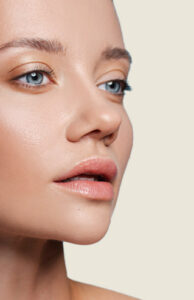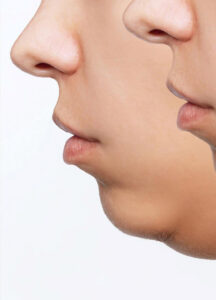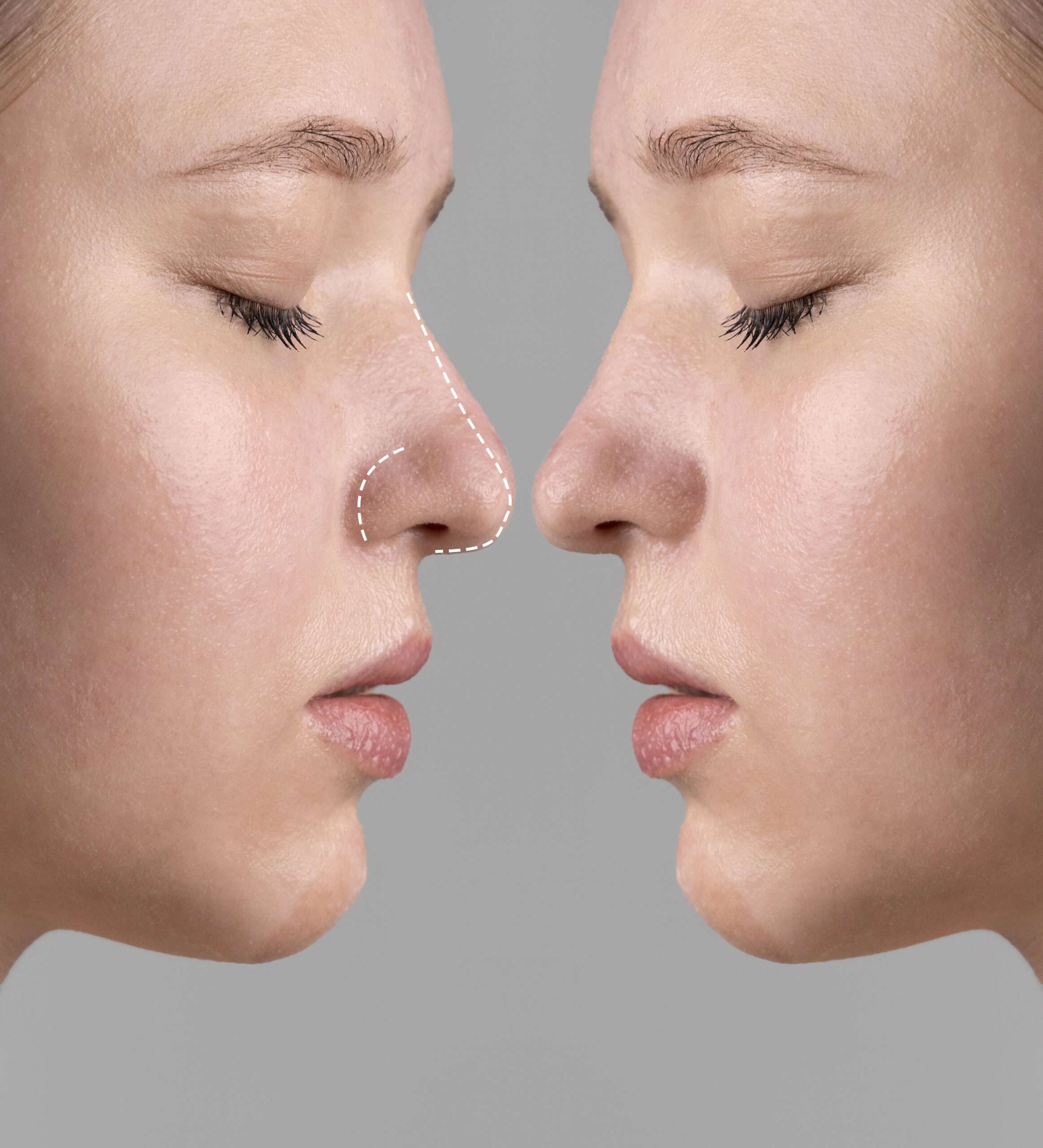

Nose surgery
Rhinoplasty
Rhinoplasty surgery consists of the removal, incorporation and repositioning of the tissues that make up the nose, in order to adapt it to the facial conformation of each patient, thereby achieving aesthetic harmony.
It can be performed by two access routes (incision, which will leave a final scar), the closed and open techniques. Each has its advantages and disadvantages.
During Rhinoplasty we work on the configurations of the nasal “skeleton”, shaping them within a certain limit imposed by each patient’s individual anatomy.
Once the nasal arch had been reconfigured, the skin was placed over it.
Further information about Rhinoplasty
- Surgical planning often involves the use of photographs, manipulated digital photographs and schematic drawings. At no point can these resources be considered as predictors of a possible final outcome. These are just resources to facilitate surgical planning.
- Depending on the case, it may be necessary to remove cartilage grafts from the nasal septum, ribs or ears. The removal of rib grafts leaves a horizontal scar in the pectoral region of approximately 7 (seven) cm (in women – in the groove below the breast, close to the external one; in men approximately four fingers above the lower edge of the ribs).
- If nasal alterations occur after surgery, X-rays and CT scans may be necessary to clarify the diagnosis.
- As well as putting mechanical stress on the new structure, which can lead to its disfigurement, trauma to the nose can also cause bruising, irregularities and deviations in the medium and long term.
- Scars evolve according to individual physiology and are generally barely noticeable, especially in the penumbra. If changes occur, there are treatments that can be used in an attempt to improve the appearance of the scars.
- There will be purple spots (ecchymoses), temporary partial or total loss of sensation and significant swelling of the nose.
- Respiratory changes can occur in the first few months after surgery, mainly due to the swelling that occurs at the site.
- Over time, the skin of the nose will thin and this can expose irregularities in the nasal structure, requiring re-intervention for correction.
- Any plastic surgery is likely to require other interventions to correct small imperfections. If further intervention is necessary, there will be no charge for medical fees, and the patient will be responsible for hospital costs.
Preoperative Rhinoplasty (nose surgery)
- 1. Obey the instructions given for admission
- 2. Report any abnormalities that may occur in their general condition.
- 3. Enter hospital fasting for at least 8 hours and do not bring valuables into the hospital.
- 4. Come accompanied to the hospital.
- 5. Avoid wearing earrings, rings, piercings, colored nail polish, etc. Any of these will be removed before surgery.
- 6. Do not take any medication or drugs up to 10 days before the scheduled date of surgery, without prior notification to the surgeon.
Post-operative Rhinoplasty (nose surgery)
- 1. Apply 30 minutes of ice every 2 hours to the nose and face for the first 48 hours.
- 2. Avoid exertion for 30 days.
- 3. Do not lower your head for 15 days, unless specifically advised by your surgeon.
- 4. Sleep with your head higher than your torso.
- 5. Get up as many times as recommended on discharge from hospital, observing the time limits for lying down or sitting, and avoiding maximum exertion.
- 6. Do not expose yourself to the sun for at least 180 days (use sunscreens or sunblocks).
- 7. Obey the doctor's prescription.
- 8. Return to the office for subsequent dressings, on the days and at the times stipulated.
- 9. Don't worry about the intermediate forms in the various phases. Ask your surgeon any questions you may have.
- 10. Normal diet (except in special cases). We recommend a high-protein diet (meat, eggs, milk) as well as fruit.
- 11. Wait to go on your "diet or slimming regime" once you have been cleared by your doctor. Anticipating such conduct on your own could lead to difficult consequences.
Other nose procedures
Before and After - Rhinoplasty
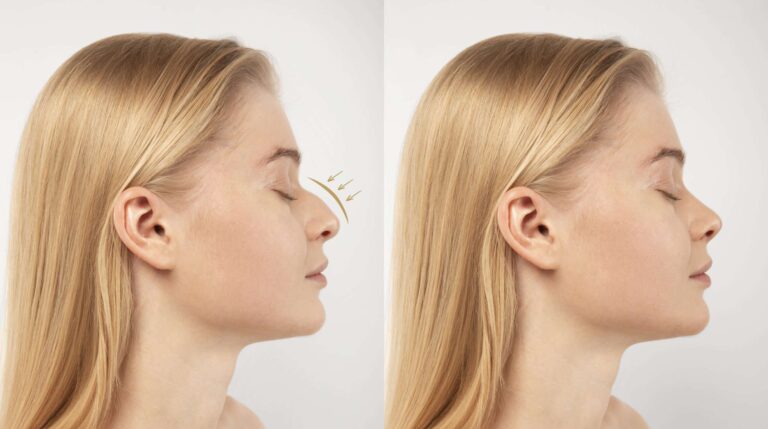

Surgeries and procedures performed by Dr. Celso Boechat
Other Plastic Surgeries in Rio de Janeiro
From stunning beaches to vibrant aesthetics, discover the plastic surgeries that reflect Rio de Janeiro’s beautiful spirit and dynamic aesthetic standards.
Breast surgery
Raise your self-esteem, reaffirm your beauty.
Body Surgeries
Transformations for your ideal body.
Facial surgery
Facial renewal, bring out your true expression.
All about rhinoplasty
Rhinoplasty: The most asked questions about nose surgery
Certain noses allow scars to be hidden inside the nasal cavity. In these cases, there will be no apparent scar. In other cases, however, there are external scars that are not very apparent, as a result of incisions (cuts) made in the columella or nasal wings to better harmonize the result or even nasal physiology.
Each patient behaves differently in relation to the evolution of the scars and in the specific case of the nose, they generally become imperceptible. Certain patients may, however, be prone to unsightly scarring (hypertrophic or keloid). This fact should be discussed at the initial consultation, as well as your family characteristics. Fair-skinned people tend to develop this type of scarring less often.
Various clinical and surgical resources allow us to improve these unsightly scars at the right time. However, hypertrophic or keloid scars should not be confused with the natural evolution of the mediate healing period. Any doubts about your healing progress should be clarified during your post-operative visits, when the stage you are at can be assessed.
Various clinical and surgical resources allow us to improve these unsightly scars at the right time. However, the “mediate period” of normal healing (from the 30th day to the 12th month) should not be confused with a healing complication. Any doubts about your progress should be clarified with your doctor.
No. There is an aesthetic balance between the nose and the face, which the surgeon must observe in order to preserve the naturalness and authenticity of the face. The quality of the skin on the nose can also affect the prognosis of the desired result. Each case is studied so that the nose can be given the best possible shape, within the requirements of the face. If your choice coincides with the type of nose you have planned, your wish will undoubtedly be granted. Surgeon and patient must agree on the possible result. In addition, the nose has numerous functions, including breathing and olfaction, which need to be respected.
No. Several phases are characteristic of the post-operative period of the nose. This is why, in the first phase (right after the immobilizing bandage is removed, around the 7th day), despite the correction of various aesthetic defects of the original nose, we notice edema (swelling) which decreases over the days and tends to normalize around 6 to 12 months. There are patients who achieve the final result a little earlier, as well as others who go beyond this period. Whether or not transient edema persists for a longer period than normal does not usually interfere with the final result.
Rhinoplasty aims to improve aesthetic conditions and, when necessary, correct some of the patient’s respiratory alterations, when these conditions are precarious in the original nose. There may be slight breathing difficulties at certain times of the day in the immediate post-operative period. Over time it tends to normalize. When correction of the septum is necessary, rhinoplasty can be performed at the same time or on a second occasion, depending on the case.
The effect of surgery on this symptom is unpredictable. The important thing is to try as much as possible to preserve respiratory functions during rhinoplasty.
The result of a rhinoplasty lasts for a long time. After a few years, as with any part of the body, there may be some morphological changes in the nasal region due to the patient’s age.
Every medical act includes a variable risk and plastic surgery, as part of medicine, is no exception. You can minimize the risk by preparing each patient properly, but you can’t eliminate it completely.
Both local anesthesia under sedation and general anesthesia can be used. It will be up to the surgical team to choose the most appropriate one.
Between one and two hours. In some cases this time is exceeded. However, surgical time should not be confused with the length of time the patient stays in the operating room, as this also includes the period of anesthetic preparation and post-operative recovery. Your doctor will be able to tell you the total time.
It can vary from half a day to a day in hospital. Depending on the type of anesthesia used and the patient’s recovery in the immediate postoperative period.
When the fracture procedure is carried out, the nose is immobilized with a plaster cast or other material, which covers it completely, for around seven to eight days. In some cases, nasal packing is used, which can be left in place for 24 to 72 hours. When combined with septoplasty or removal of the nasal conchae, the length of time the tampons are in place can be extended.
There is a little bleeding, which is normal in the first 48 hours. This shouldn’t be a cause for concern, however, as a protective bandage over the opening of the nose is purposely kept in place in order to sanitize this bleeding. This additional dressing can be changed at home as often as necessary.
Rarely. Rhinoplasty is generally comfortable in the post-operative period. When pain does occur, it is usually treated with common painkillers.
Always with the head discreetly raised off the bed (two pillows). Keep your face up whenever possible.
As long as there are bruises, it is advisable to avoid sun exposure.
Until the desired result is achieved, several evolutionary phases are characteristic of this type of surgery. This is why oedema (swelling), “patches” of blood infiltrate and difficulty breathing in the first few days are common, and some people experience these phenomena less intensely than others. Any concerns you may have should be passed on to your plastic surgeon. Remember that no results from cosmetic surgery of the nose should be evaluated before the period between the 6th and 12th days. post-operative month.
Possible risks of Rhinoplasty
Rhinoplasty, like any other surgery, has risks and complications, some of which are specific to it and others which are generic to any type of surgery. These include:
Generic
1. Allergies: Some medications or products used during surgery can cause allergic reactions, which can even lead to death. Allergic reactions are patient-dependent and can occur either to medicines or products that the patient has never had contact with, or to those that they have had previous contact with, even if they didn’t have a previous reaction.
2. Scarring: Changes in scarring can occur, such as dark or light coloration, widening, hypertrophy or keloids. Regular post-operative visits enable early diagnosis and control of these changes
3. Hematoma: Accumulation of blood in the operated area, from a vessel that was not bleeding at the end of the operation, but did so in the immediate post-operative period. It can be treated by aspiration with a syringe and needle or, rarely, re-operation may be necessary.


Book your appointment
Find out everything you need in one consultation
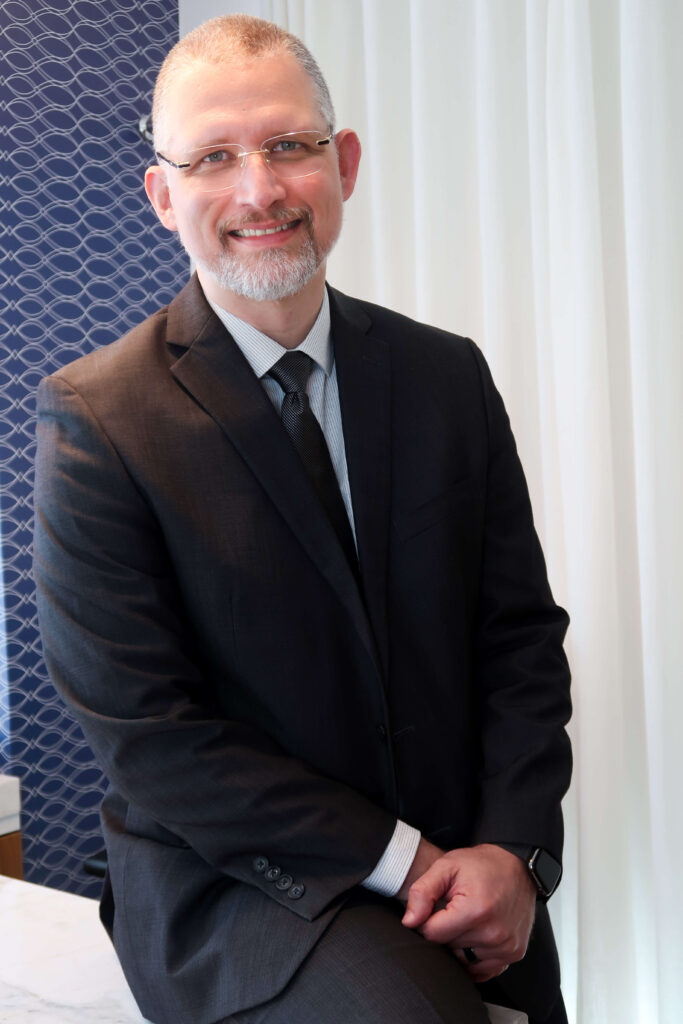

Appointment
Make an appointment and get your questions answered
Schedule an appointment with plastic surgeon Dr. Celso Boechat. Discover the path to aesthetic transformation and improved self-esteem. Our specialized team is ready to guide you through the procedure options, answering your questions and creating a personalized plan to suit your needs. Book your appointment now and take the first step towards a more confident and radiant version of yourself.
Send a message via WhatsApp
Service and consultations
Call Us
(21) 997336862
Opening hours
Monday to Friday - 09:00 - 21:00
Saturdays and Sundays - Closed, only for surgeries
